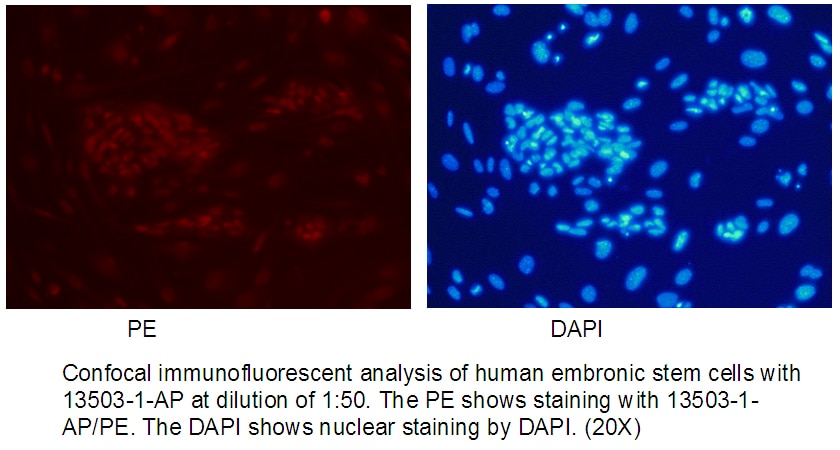REX1 Polyklonaler Antikörper
REX1 Polyklonal Antikörper für IF/ICC, ELISA
Wirt / Isotyp
Kaninchen / IgG
Getestete Reaktivität
human
Anwendung
IF/ICC, ELISA
Konjugation
Unkonjugiert
Kat-Nr. : 13503-1-AP
Synonyme
Geprüfte Anwendungen
| Erfolgreiche Detektion in IF/ICC | humane embryonale Stammzellen |
Empfohlene Verdünnung
| Anwendung | Verdünnung |
|---|---|
| Immunfluoreszenz (IF)/ICC | IF/ICC : 1:20-1:200 |
| It is recommended that this reagent should be titrated in each testing system to obtain optimal results. | |
| Sample-dependent, check data in validation data gallery | |
Produktinformation
13503-1-AP bindet in IF/ICC, ELISA REX1 und zeigt Reaktivität mit human
| Getestete Reaktivität | human |
| Wirt / Isotyp | Kaninchen / IgG |
| Klonalität | Polyklonal |
| Typ | Antikörper |
| Immunogen | REX1 fusion protein Ag4334 |
| Vollständiger Name | REX1, RNA exonuclease 1 homolog (S. cerevisiae) |
| Berechnetes Molekulargewicht | 1221 aa, 132 kDa |
| Beobachtetes Molekulargewicht | 132 kDa |
| GenBank-Zugangsnummer | BC032244 |
| Gene symbol | REX1 |
| Gene ID (NCBI) | 57455 |
| Konjugation | Unkonjugiert |
| Form | Liquid |
| Reinigungsmethode | Antigen-Affinitätsreinigung |
| Lagerungspuffer | PBS with 0.02% sodium azide and 50% glycerol |
| Lagerungsbedingungen | Bei -20°C lagern. Nach dem Versand ein Jahr lang stabil Aliquotieren ist bei -20oC Lagerung nicht notwendig. 20ul Größen enthalten 0,1% BSA. |
Hintergrundinformationen
REXO1, also named as EloA-BP1, ELOABP1, KIAA1138 and TCEB3BP1, is transcription elongation factor B polypeptide 3-binding protein 1. REXO1 did not affect either the rate of transcription elongation by RNA polymerase II or the transcriptional activity of TCEB3 in vitro. This gene is different to the REX1 which is an embryo stem cell marker.
Rezensionen
The reviews below have been submitted by verified Proteintech customers who received an incentive for providing their feedback.
FH Ivan (Verified Customer) (10-30-2021) | Just showed unspecific bands, no band where tagged Rexo1 is. Also, very very weak (but then again, the protein is lowly expressed...)
|


